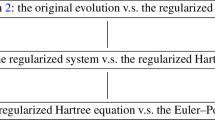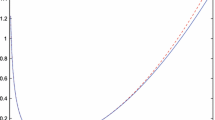Abstract
This paper presents a thorough examination of the thermodynamic limit of the pressure function for the mean-field Ising model with four-body interaction. By utilizing a standard entropic variational principle and decoupling method, both upper and lower bounds were derived, and interestingly, these bounds shared the same local maxima. Additionally, the paper explores and solves the inverse problem related to the mean-field Ising model with four-body interaction. We established a connection between the analytical inversion and statistical observations by utilizing the maximum likelihood criteria and creating a relationship between the estimated and theoretical values.







Similar content being viewed by others
Data availability
No data were used for this work.
References
E.T. Jaynes, Information theory and statistical mechanics. Phys. Rev. 106(4), 620 (1957)
D.J.C. MacKay, Information theory, inference and learning algorithms. Cambridge university press, (2003)
P. Contucci, G. Osabutey, C. Vernia. The inverse problem beyond two-body interaction: the cubic mean-field ising model. arXiv preprint arXiv:2210.03260, (2022)
Y. Ma, M. Huang, Linear quadratic mean field games with a major player: the multi-scale approach. Automatica 113, 108774 (2020)
M. Huang, M. Zhou. Linear quadratic mean field games–part i: The asymptotic solvability problem. arXiv preprint arXiv:1811.00522, (2018)
M. Huang, M. Zhou, Linear quadratic mean field games: asymptotic solvability and relation to the fixed point approach. IEEE Trans. Autom. Control 65(4), 1397–1412 (2019)
N. Li, X. Li, Y. Zhiyong, Indefinite mean-field type linear-quadratic stochastic optimal control problems. Automatica 122, 109267 (2020)
X. Li, J. Sun, J. Yong, Mean-field stochastic linear quadratic optimal control problems: closed-loop solvability. Prob. Uncertain. Quant. Risk 1, 1–24 (2016)
N.P. Bondarenko, A.V. Gaidel, Solvability and stability of the inverse problem for the quadratic differential pencil. Mathematics 9(20), 2617 (2021)
H. Hibon, Y. Hu, S. Tang. Mean-field type quadratic bsdes. arXiv preprint arXiv:1708.08784, (2017)
R. Beinert, K. Bredies. Tensor-free proximal methods for lifted bilinear/quadratic inverse problems with applications to phase retrieval. Found. Comput. Math., pages 1–52, (2021)
R. Kh Amırov, A. Adiloglu Nabıev. Inverse problems for the quadratic pencil of the sturm-liouville equations with impulse. In Abstract and Applied Analysis, volume 2013. Hindawi (2013)
H.M. Lin, B. Dong, M.T. Chu, Inverse mode problems for real and symmetric quadratic models. Inverse Prob. 26(6), 065003 (2010)
T. Kühn, F. van Wijland, Diagrammatics for the inverse problem in spin systems and simple liquids. J. Phys. A Math. Theor. 56(11), 115001 (2023)
V.M. Poulsen, S. DeDeo, Inferring cultural landscapes with the inverse Ising model. Entropy 25(2), 264 (2023)
Y. Wang, T. Zhou, Inverse problems for quadratic derivative nonlinear wave equations. Commun. Partial Diff. Equ. 44(11), 1140–1158 (2019)
S. Arridge, P. Maass, O. Öktem, C.-B. Schönlieb, Solving inverse problems using data-driven models. Acta Numer. 28, 1–174 (2019)
P. Contucci, J. Kertész, G. Osabutey, Human-ai ecosystem with abrupt changes as a function of the composition. PloS one 17(5), e0267310 (2022)
H.C. Nguyen, R. Zecchina, J. Berg, Inverse statistical problems: from the inverse Ising problem to data science. Adv. Phys. 66(3), 197–261 (2017)
H.C. Nguyen, J. Berg, Mean-field theory for the inverse at Ising problem low temperatures. Phys. Rev. Let. 109(5), 050602 (2012)
A. Decelle, F. Ricci-Tersenghi, Solving the inverse Ising problem by mean-field methods in a clustered phase space with many states. Phys. Rev. 94(1), 012112 (2016)
M.B. Kloucek, T. Machon, S. Kajimura, C.P. Royall, N. Masuda, F. Turci. Biases in inverse ising estimates of near-critical behaviour. (2023) arXiv preprint arXiv:2301.05556
M.A. Valle, G.A. Ruz, S. Rica, Discovering pairwise interaction strengths among products, Market basket analysis by solving the inverse ising problem. Physica A: Stat. Mech. Appl. 524, 36–44 (2019)
M. Fedele, C. Vernia, P. Contucci, Inverse problem robustness for multi-species mean-field spin models. J. Phys. A Math. Theor. 46(6), 065001 (2013)
L. Litinskii, B. Kryzhanovsky, Inverse problem for Ising connection matrix with long-range interaction. Mathematics 9(14), 1624 (2021)
T. Sano, A noniterative solution to the inverse Ising problem using a convex upper bound on the partition function. J. Stat. Mech. Theory Exp. 2022(2), 023406 (2022)
S. Deyo, Solving a directed-percolation inverse problem. Phys. Rev. E 106(1), 014305 (2022)
F. Battiston, G. Cencetti, I. Iacopini, V. Latora, M. Lucas, A. Patania, J.-G Young, G. Petri, Networks beyond pairwise interactions: structure and dynamics. Phys. Rep. 874, 1–92 (2020)
A.R. Benson, R. Abebe, M.T. Schaub, A. Jadbabaie, J. Kleinberg, Simplicial closure and higher-order link prediction. Proc. Nat. Acad. Sci. 115(48), E11221–E11230 (2018)
F. Battiston, E. Amico, A. Barrat, G. Bianconi, G. Ferraz de Arruda, B. Franceschiello, I. Iacopini, S. Kéfi, V. Latora, Y. Moreno et al., The physics of higher-order interactions in complex systems. Nature Phys. 17(10), 1093–1098 (2021)
B. Subramanian, J. Lebowitz, The study of a three-body interaction Hamiltonian on a lattice. J. Phys. A Math. Gen. 32(35), 6239 (1999)
V. Barsan, Siewert solutions of transcendental equations, generalized lambert functions and physical applications. Open Phys. 16(1), 232–242 (2018)
J. Jalowy, M. Löwe, H. Sambale, Fluctuations of the magnetization in the block potts model. J. Stat. Phys. 187(1), 1–24 (2022)
P. Marton, V. Stepkova, J. Hlinka, Divergence of dielectric permittivity near phase transition within ferroelectric domain boundaries. Phase Trans. 86(1), 103–108 (2013)
A.A. Opoku, G. Osabutey. Multipopulation spin models: a view from large deviations theoretic window. J. Math. (2018)
A. Voss-Böhme. Multi-scale modeling in morphogenesis: a critical analysis of the cellular potts model. (2012)
S.V. Beentjes and A. Khamseh, Higher-order interactions in statistical physics and machine learning: a model-independent solution to the inverse problem at equilibrium. Phys. Rev. E 102(5), 053314 (2020)
I. Gallo. An equilibrium approach to modelling social interaction. arXiv preprint arXiv:0907.2561, (2009)
F. Guerra. Mathematical aspects of mean field spin glass theory. arXiv preprint cond-mat/0410435, (2004)
F. Guerra. Spin glasses. arXiv preprint cond-mat/0507581, (2005)
L. De Sanctis. Structural approaches to spin glasses and optimization problems. Princeton University, (2005)
D. Ruelle. Statistical mechanics–rigorous results, reprint, (1989)
J. Zhu, J. Wang, W. Han, X. Dong, Neural relational inference to learn long-range allosteric interactions in proteins from molecular dynamics simulations. Nat. Commun. 13(1), 1661 (2022)
A. Sanyal, B.R. Lajoie, G. Jain, J. Dekker, The long-range interaction landscape of gene promoters. Nature 489(7414), 109–113 (2012)
Acknowledgements
The authors thank the staff at the Mathematics and Statistics Department of University of Energy and Natural Resources, Department of Statistics and Actuarial Science, Kwame Nkrumah University of Science and Technology, and Department of Mathematics, Kwame Nkrumah University of Science and Technology for their support and kindness during the period this paper was written.
Author information
Authors and Affiliations
Corresponding author
Ethics declarations
Conflict of interest
The authors declare that they have no conflicts of interest.
Rights and permissions
Springer Nature or its licensor (e.g. a society or other partner) holds exclusive rights to this article under a publishing agreement with the author(s) or other rightsholder(s); author self-archiving of the accepted manuscript version of this article is solely governed by the terms of such publishing agreement and applicable law.
About this article
Cite this article
Ansah, R.K., Boadi, R.K., Obeng-Denteh, W. et al. Inverse problem for the quartic mean-field Ising model. Eur. Phys. J. Plus 138, 626 (2023). https://doi.org/10.1140/epjp/s13360-023-04251-3
Received:
Accepted:
Published:
DOI: https://doi.org/10.1140/epjp/s13360-023-04251-3




